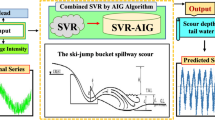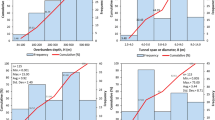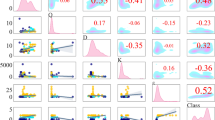Abstract
Estimation of scour downstream of a ski-jump bucket has been a topic of research among hydraulic engineers. For estimation of scour downstream of ski jump bucket, several empirical models are in use. In recent years, there has been emphasis to develop models which are capable of producing scour with high accuracy. Use of Artificial Neural Network (ANN) approach to model depth, width and length of scour hole indicates that performance of ANN models is far better than existing empirical models. At present, use of Support Vector Machines (SVMs) and M5 Pruned Model Tree are being considered in different disciplines to further improve upon the performance of ANN models as a potential alternate. With this in view, the present study deals with the development of regression models for computing various parameters of scour hole using SVMs and M5 Model Tree. A comparative evaluation of the performance of ANN versus SVMs and M5 Model Tree clearly shows that SVMs and M5 Model Tree can prove more useful than ANN models in estimation of scour downstream of a ski jump bucket. Further, M5 model tree offers explicit expressions for use by design engineers.
Similar content being viewed by others
References
Altunkaynak A (2007) Forecasting surface water level fluctuations of Lake Van by artificial neural networks. Water Resour Manage 21(2):399–408
Annandale GW (2006) Review of scour technology. McGraw-Hill, New York, p 430. ISBN 0-07-144057-7
Azmathullah HM, Ghani AAB (2010) Genetic programming for predicting longitudinal dispersion coefficients in streams. Water Resour Manage. doi:10.1007/s11269-010-9759-9
Azmathullah HM, Deo MC, Deolalikar PB (2005) Neural networks for estimation of scour downstream of a ski-jump bucket. J Hydraul Eng 131(10):898–908
Azmathullah HM, Deo MC, Deolalikar PB (2006) Estimation of scour below spillways using neural networks. IAHR J Hydraul Res 44(1):61–69
Azmathullah HM, Deo MC, Deolalikar PB (2008a) Alternative neural networks to estimate the scour below spillways. Adv Eng Softw 39:689–698
Azmathullah HM, Ghani AAB, Zakaria NA, Hin LS, Kiat CC, Siang LC, Hasan ZA (2008b) Genetic programming to predict ski-jump bucket spillway scour. J Hydrodynam 20(4):477–484
Azmathullah HM, Ghani AAB, Zakaria NA (2009) ANFIS based approach for predicting maximum scour location of spillway. Water Manag ICE Lond 162(6):399–407
Azmathullah HM, Ghani AAb, Zakaria NA (2010) Prediction of scour below flip bucket using soft computing techniques AIP Conf. Proc. May, 2010, 1233:1588–1593 proceedings of the 2nd international symposium on computational mechanics and the 12th international conference on the enhancement and promotion of computational methods in engineering and science. doi:10.1063/1.3452146
Bhattacharya B, Solomatine DP (2005) Neural networks and M5 model trees in modelling water level–discharge relationship. Neurocomputing 63:381–396
Bhattacharya B, Price RK, Solomatine DP (2007) Machine learning approach to modeling sediment transport. J Hydraul Eng 133(4):440–450
Bollaert EFR, Schleiss AJ (2003) Scour of rock due to the impact of plunging high-velocity jets. Part II: experimental results of dynamic pressures at pool bottoms and in one and two-dimensional closed end rock joints. J Hydraul Res 41(5):15–30
Bollaert EFR, Schleiss AJ (2005) Physically based model for evaluation of rock scour due to high velocity jet impact. J Hydraul Eng 131(3):153–165
Breiman L, Friedman JH, Olshen RA, Stone CJ (1984) Classification and regression trees. Wadsworth, Belmont
Chang CC, Lin CJ (2001) LIBSVM: a library for support vector machines. Software available at http://www.csie.ntu.edu.tw/∼cjlin/libsvm
Gandhi AB, Joshi JB, Jayaraman VK, Kulkarni BD (2007) Development of support vector regression (SVR)-based correlation for prediction of overall gas hold-up in bubble column reactors for various gas-liquid systems. Chem Eng Sci 62:7078
Goyal MK, Ojha CSP (2010a) Downscaling of surface temperature for lake catchment in arid region in India using linear multiple regression and neural networks. Int J Climatol. doi:10.1002/joc.2286
Goyal MK, Ojha CSP (2010b) Analysis of mean monthly rainfall runoff data of Indian catchments using dimensionless variables by neural network. Journal of Environmental Protection 1(2):155–171
Goyal MK, Ojha CSP, Burn Donald H (2010) An evaluation of decision tree algorithm as a downscaling tool: application on a Lake Basin for an arid region in India. In: Tenth conference of Canadian geophysical union. University of Guelph, Ontario, Canada, Dec. 2010
Goyal MK, Ojha CSP (2011) Downscaling of precipitation on a Lake Basin: evaluation of rule and decision tree induction algorithms. Hydrology Research (accepted)
Gunn SR (1998) Support vector machines for classification and regression. Technical Report, department of electronics and computer science, University of Southampton
Hong WC, Pai PF (2007) Potential assessment of the support vector regression technique in rainfall forecasting. Water Resour Manage 21(2):495–513
Hua XG, Ni YQ, Ko JM, Wong KY (2007) Modeling of temperature frequency correlation using combined principal component analysis and support vector regression technique. J Comput Civ Eng 21(2):122–135
Lee KT, Hung WC, Meng CC (2008) Deterministic insight into ANN model performance for storm runoff simulation. Water Resour Manage 22(1):67–82
Lopardo RA, Lopardo MC, Casado JM (2002) Local rock scour downstream large dams. In: Proc. Int. Workshop on Rock Scour Due to High Velocity Jets. Lausanne, Switzerland, pp 55–58
Martins RBF (1975) Scouring of rocky river beds by free jet spillways. Int Water Power Dam Constr 27(4):152–153
Mason PJ, Arumugam K (1985) Free jet scour below dams and flip buckets. J Hydraul Eng 111(2):220–235
Nourani V, Komasi M, Mano A (2009) A multivariate ANN-wavelet approach for rainfall–runoff modeling. Water Resour Manage 23(14):2877–2894
Ojha CSP, Goyal MK, Adeloye AJ (2010) Downscaling of precipitation for lake catchment in arid region in India using linear multiple regression and neural networks. The Open Journal of Hydrology 4:122–136
Pal M, Goel A (2007) Estimation of discharge and end depth in trapezoidal channel by support vector machines. Water Resour Manage 21(10):1763–1780
Quinlan JR (1992) Learning with continuous classes. In: Adams A, Sterling L (eds) Proceedings of the 5th Australian joint conference on artificial intelligence. World Scientific, Singapore, pp 343–348
Rame Gowda BM, Ghosh N, Wadhwa RS, Chaudhari MS, Chandrasekhar V, Subbarao Ch (1999) Seismic survey for detecting scour depths downstream of the Srisailam dam, Andhra Pradesh, India. Eng Geol 53(1):35–46
Singh KK, Pal M, Ojha CSP, Singh VP (2008) Estimation of removal efficiency for settling basins using neural networks and support vector machines. J Hydrol Eng 13(3):146–155
Singh KK, Pal M, Singh VP (2010) Estimation of mean annual flood in Indian catchments using back propagation neural network and M5 model tree. Water Resour Manage 24:2007–2019
Shrestha DL, Solomatine DP (2006) Machine learning approaches for estimation of prediction interval for the model output. Neural Netw 19(2):225–235
Smola AJ, Scholkopf B (2004) A tutorial on support vector regression. Stat Compass 14:199
Sohail A, Watanabe K, Takeuchi S (2008) Runoff analysis for a small watershed of Tono Area Japan by back propagation artificial neural network with seasonal data. Water Resour Manage 22(1):1–22
Solomatine DP, Dulal KN (2003) Model tree as an alternative to neural network in rainfall–runoff modelling. Hydrol Sci J 48(3):399–411
Solomatine DP, Yunpeng X (2004) M5 model trees and neural networks: application to flood forecasting in the upper reach of the Huai River in China. J Hydrol Eng 9(6):491–501
Vapnik VN (1995) The nature of statistical learning theory. Springer, New York
Veronese A (1937) Erosion de fondo a valle di uno scarico. Ann Lav Pubblicci 75(9):717–726
Wang Y, Witten IH (1997) Induction of model trees for predicting continuous classes. In: Poster papers of the 9th European conference on machine learning
Witten IH, Frank E, Trigg L, Hall M, Holmes G, Cunningham SJ (1999) Weka: practical machine learning tools and techniques with java implementations. In: Emerging knowledge engineering and connectionist-based info. systems, pp 192–196
Wu CH, Wei CC, Su DC, Chang MH, Ho JM (2003) Travel time prediction with support vector regression. In: Proc. IEEE intelligent transportation systems conf., vol. 2. Shanghai, China, Oct. 12–15, 2003, pp 1438–1442
Yongli MA, Zongjue Qian, Guochu Shou, Yihong Hu (2008) Study on preliminary performance of algorithms for network traffic identification. In: International conference on computer science and software engineering, pp 629–633. doi:10.1109/CSSE.2008.1277
Author information
Authors and Affiliations
Corresponding author
Rights and permissions
About this article
Cite this article
Goyal, M.K., Ojha, C.S.P. Estimation of Scour Downstream of a Ski-Jump Bucket Using Support Vector and M5 Model Tree. Water Resour Manage 25, 2177–2195 (2011). https://doi.org/10.1007/s11269-011-9801-6
Received:
Accepted:
Published:
Issue Date:
DOI: https://doi.org/10.1007/s11269-011-9801-6




